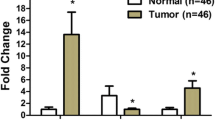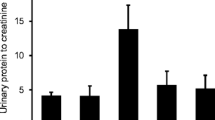Abstract
Several authors have investigated the antitumor activity of angiotensin II type 1 receptor (AT1 R) antagonists, which are widely used as antihypertensive drugs. In this study, we evaluated the efficacy of the AT1 R antagonist candesartan against bladder cancer. For the study in vitro, human bladder cancer cells (KU-19-19) were cultured with and without angiotensin II (A II) and candesartan, and cell viability and vascular endothelial growth factor (VEGF) secretion were analyzed. Also for the study in vivo, a tumor xenograft model was prepared in nude mice using KU-19-19 cells. Mice were administered candesartan daily by oral gavage, and paclitaxel via intravenous infusion. Microvessel density, VEGF expression, and apoptosis were investigated. Candesartan did not induce direct toxicity in KU-19-19 cells, but VEGF was significantly lower in candesartan-treated cells than in the A II-treated control cells. In mice, candesartan, paclitaxel and candesartan-paclitaxel significantly suppressed tumor growth to 46.0%, 35.8% and 17.3%, respectively, of the tumor volume in the control group, showing that combined treatment significantly inhibited tumor growth compared to the candesartan group. Microvessel density and VEGF were significantly decreased in the candesartan and candesartan-paclitaxel groups compared to the control group. The apoptotic index was significantly increased in the paclitaxel and candesartan-paclitaxel groups compared to the control and candesartan groups. In our experimental model, candesartan prevented bladder cancer growth by inhibiting angiogenesis. Furthermore, combined treatment with candesartan and paclitaxel enhanced paclitaxel-induced cytotoxicity. These results suggest that the AT1 R antagonist candesartan may be a candidate for innovative therapy for bladder cancer.
Similar content being viewed by others
References
Lever AF, Hole DJ, Gillis CR et al. Do inhibitors of angiotensin-I-converting enzyme protect against risk of cancer? Lancet 1998; 352: 179–84.
Fujimoto Y, Sasaki T, Tsuchida A, Chayama K. Angiotensin II type 1 receptor expression in human pancreatic cancer and growth inhibition by angiotensin II type 1 receptor antagonist. FEBS Lett 2001; 495: 197–200.
Egami K, Murohara T, Shimada T et al. Role of host angiotensin II type 1 receptor in tumor angiogenesis and growth. J Clin Invest 2003; 112: 67–75.
Miyajima A, Kosaka T, Asano T et al. Angiotensin II type 1 antagonist prevents pulmonary metastasis of murine renal cancer by inhibiting tumor angiogenesis. Cancer Res 2002; 62: 4176–9.
Koh WP, Yuan JM, Van Den Berg D, Lee HP, Yu MC. Polymorphisms in angiotensin II type 1 receptor and angiotensin I-converting enzyme genes and breast cancer risk among Chinese women in Singapore. Carcinogenesis 2005; 26: 459–64.
Juillerat-Jeanneret L, Celerier J, Chapuis Bernasconi C et al. Renin and angiotensinogen expression and functions in growth and apoptosis of human glioblastoma. Br J Cancer 2004; 90: 1059–68.
Fujita M, Hayashi I, Yamashina S, Itoman M, Majima M. Blockade of angiotensin AT1a receptor signaling reduces tumor growth, angiogenesis, and metastasis. Biochem Biophys Res Commun 2002; 294: 441–7.
Tachibana M, Miyakawa A, Nakashima J et al. Constitutive production of multiple cytokines and a human chorionic gonadotrophin β-subunit by a human bladder cancer cell line (KU19-19): possible demonstration of totipotential differentiation. Br J Cancer 1997; 76: 163–74.
Inoue K, Slaton JW, Davis DW et al. Treatment of human metastatic transitional cell carcinoma of the bladder in a murine model with the anti-vascular endothelial growth factor receptor monoclonal antibody DC101 and paclitaxel. Clin Cancer Res 2000; 6: 2635–43.
Ahmed SA, Gogal RM Jr, Walsh JE. A new rapid and simple non-radioactive assay to monitor and determine the proliferation of lymphocytes: an alternative to [3H]thymidine incorporation assay. J Immunol Meth 1994; 170: 211–24.
Kumar R, Yoneda J, Bucana DC, Fidler IJ. Regulation of distinct steps of angiogenesis by different angiogenic molecules. Int J Oncol 1998; 12: 749–57.
Droller MJ. Vascular endothelial growth factor is a predictor of relapse and stage progression in superficial bladder cancer. J Urol 1998; 160: 1932.
Crew JP. Vascular endothelial growth factor: an important angiogenic mediator in bladder cancer. Eur Urol 1999; 35: 2–8.
Eggert A, Ikegaki N, Kwiatkowski J, Zhao H, Brodeur GM, Himelstein BP. High-level expression of angiogenic factors is associated with advanced tumor stage in human neuroblastomas. Clin Cancer Res 2000; 6: 1900–8.
Rivera E, Arrieta O, Guevara P, Duarte-Rojo A, Sotelo J. AT1 receptor is present in glioma cells; its blockage reduces the growth of rat glioma. Br J Cancer 2001; 85: 1396–9.
Ringel I, Horwitz SB. Taxol is converted to 7-epitaxol, a biologically active isomer, in cell culture medium. J Pharmacol Exp Ther 1987; 242: 692–8.
Manfredi JJ, Parness J, Horwitz SB. Taxol binds to cellular microtubules. J Cell Biol 1982; 94: 688–96.
Jordan MA, Wendell K, Gardiner S, Derry WB, Copp H, Wilson L. Mitotic block induced in HeLa cells by low concentrations of paclitaxel (Taxol) results in abnormal mitotic exit and aoptotic cell death. Cancer Res 1996; 56: 816–25.
Derry WB, Wilson L, Jordan MA. Substoichiometric binding of taxol suppresses microtubule dynamics. Biochemistry 1995; 34: 2203–11.
Author information
Authors and Affiliations
Corresponding author
Rights and permissions
About this article
Cite this article
Kosugi, M., Miyajima, A., Kikuchi, E. et al. Effect of angiotensin II type 1 receptor antagonist on tumor growth and angiogenesis in a xenograft model of human bladder cancer. Hum Cell 20, 1–9 (2007). https://doi.org/10.1111/j.1749-0774.2007.00025.x
Received:
Accepted:
Published:
Issue Date:
DOI: https://doi.org/10.1111/j.1749-0774.2007.00025.x




